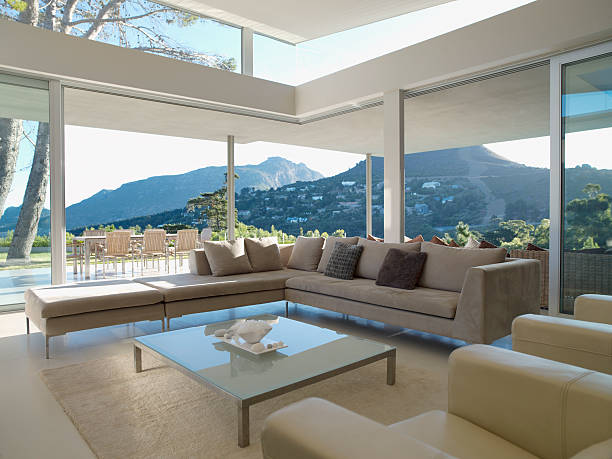
Glass has emerged as an indispensable material in architecture and interior design, playing a multifaceted role that extends beyond its practical applications. From enhancing natural light to creating aesthetic appeal, glass continues to redefine the way we perceive and interact with spaces. This article will delve into the various impacts of glass on architecture and interior design, showcasing why it's a staple in modern construction and design.
Historical Overview: The Evolution of Glass in Architecture
The use of glass in architecture dates back to ancient times, but it truly gained prominence during the Roman era. Initially, glass was a luxury material used sparingly due to its high cost and limited availability. The advent of larger, clearer glass panes during the Gothic period marked a significant shift, particularly with the introduction of stained glass windows in cathedrals. These windows served both aesthetic and functional purposes, providing light and beauty while narrating religious stories. The 17th century saw the invention of plate glass, which revolutionized architecture by making large windows and glass facades possible. This innovation laid the groundwork for the extensive use of glass in contemporary buildings.
Natural Light and Sustainability: A Perfect Blend
One of the most notable benefits of glass in modern architecture is its ability to maximize natural light. Large windows, skylights, and glass walls allow sunlight to flood indoor spaces, reducing the reliance on artificial lighting. This not only enhances the aesthetic appeal of a space but also contributes to energy efficiency, aligning with the principles of sustainable architecture. Glass can also play a role in passive solar heating, where it allows sunlight to warm interiors naturally, thus cutting down on heating costs.
Visual Transparency and Aesthetic Brilliance
Glass offers a unique quality of visual transparency that can transform the dynamics of architectural spaces. By replacing solid walls with glass partitions, designers can create an open, airy ambiance that fosters a sense of connectivity between different areas. This openness is especially desirable in contemporary architecture, where the seamless flow of spaces is a critical design goal. The sleek, modern look of glass also complements a variety of interior styles, from minimalist to luxury, making it a versatile choice for any design palette.
Innovations in Glass Technology: Moving Beyond the Ordinary
Technological advancements have significantly expanded the possibilities for using glass in architecture and interior design. Innovations such as tempered glass, laminated glass, and low-emissivity (Low-E) coatings have enhanced the material's safety, durability, and energy efficiency. Smart glass technologies, which can change opacity on demand, offer dynamic control over privacy and light levels. These technological strides have not only made glass a more practical choice but also opened up exciting new design avenues. By adopting these cutting-edge solutions, you can elevate your high-quality frame and glass updates with Next Door and Window to achieve unparalleled results.
Safety and Durability: Addressing Concerns
The initial fragility of glass raised concerns about its safety in architectural applications. However, modern glass products have been engineered to withstand significant impact and stress. Tempered glass, produced through a heating and cooling process, is much more resistant to breakage than regular glass. Laminated glass, comprising layers of glass with an interlayer of polyvinyl butyral (PVB), remains intact even when shattered, thus preventing injuries. These innovations ensure that glass can be safely used in high-traffic areas and buildings exposed to extreme weather conditions. When you choose Next Door and Window, you can elevate your high-quality frame and glass updates with confidence, knowing they meet the highest safety and durability standards.
Acoustic Control: A Quieter, More Comfortable Environment
Beyond its visual and functional benefits, glass also plays a crucial role in acoustic control. Specialized acoustic glass is designed to reduce noise pollution, making it an ideal choice for buildings in noisy urban environments or near highways and airports. By incorporating acoustic glass, architects can create peaceful indoor spaces shielded from external noise, enhancing comfort and productivity. This is particularly beneficial in residential buildings, offices, and hotels where serenity is paramount.
Artistic Expressions and Customization: Creativity Unbounded
Glass provides endless opportunities for artistic expression and customization. From etched and frosted glass that offers privacy while adding a decorative touch, to colored glass that introduces playful hues and patterns, the design possibilities are limitless. Stained glass continues to be a cherished art form, bringing both historical elegance and modern flair to contemporary spaces. Custom-printed glass can feature unique designs or branding elements, making it a popular choice for corporate environments and retail spaces. By working with Next Door and Window, you can elevate your high-quality frame and glass updates with bespoke artistic elements that reflect your unique vision and style.
Future Trends and Innovations: What Lies Ahead
The future of glass in architecture and interior design is bright, with continuous research and development leading to groundbreaking applications. One emerging trend is photovoltaic glass, which can generate solar power while serving as a building material. This innovation merges the aesthetic and functional roles of glass with the growing demand for sustainable energy solutions. Another exciting development is 3D-printed glass, which allows for intricate and previously impossible designs, pushing the boundaries of architectural creativity. As we look to the future, the role of glass in creating innovative, beautiful, and sustainable buildings is set to expand even further.
Conclusion
Glass has undeniably revolutionized architecture and interior design, evolving from a luxury material to an essential component in modern construction. Its ability to harness natural light, provide visual transparency, and support sustainable design makes it indispensable in contemporary architecture. Technological advancements have addressed safety concerns, improved durability, and expanded the artistic possibilities of glass. By choosing Next Door and Window, you can elevate your high-quality frame and glass updates to meet and exceed contemporary design standards. As we move forward, the role of glass in shaping our built environment promises to be more significant than ever, enriching our spaces and enhancing our experience of the world around us.